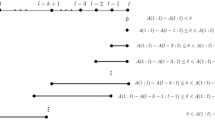Abstract
We derive a general principle demonstrating that by partitioning the feasible set, the duality gap, existing between a nonconvex program and its lagrangian dual, can be reduced, and in important special cases, even eliminated. The principle can be implemented in a Branch and Bound algorithm which computes an approximate global solution and a corresponding lower bound on the global optimal value. The algorithm involves decomposition and a nonsmooth local search. Numerical results for applying the algorithm to the pooling problem in oil refineries are given.
Similar content being viewed by others
References
E. Alperovits and U. Shamir, “Design of optimal water distribution system,”Water Resources Research 13(6) (1977) 885–900.
B. Bank, J. Guddat, D. Klatte, B. Kummer and K. Tammer,Nonlinear Parametric Optimization (Birkhauser, Basel, 1983).
A. Ben-Tal, G. Eiger, J. Outrata and J. Zowe, “A nondifferential approach to decomposable optimization problems with an application to the design of water distribution networks,” in: W. Oettlie and D. Pallaschke, eds.,Advances in Optimization, Lecture Notes in Econom. and Math. Syst. No. 382 (Springer, Berlin, 1992).
C.A. Floudas and A. Aggarwal, “A decomposition approach for global optimum search in the pooling problem,”ORSA Journal on Computing 2(3) (1990) 225–235.
C.A. Floudas and P.M. Pardalos, “A collection of test problems for constrained global optimization algorithms,”Lecture Notes in Comput. Sci. No. 455 (Springer, Berlin, 1987).
C.A. Floudas and V. Visweswaran, “A global optimization algorithm (GOP) for certain classes of nonconvex NLPs: I. Theory,”Computers and Chemical Engineering 14(12) (1990) 1397–1417.
C.A. Floudas and V. Visweswaran, “A primal-relaxed dual global optimization approach,” to appear in:Journal of Optimization Theory and Applications (1992).
O. Fujiwara and D.B. Khang, “A two-phase decomposition method for optimal design of looped water distribution networks,”Water Resources Research 26(4) (1990) 539–549.
O.L. Mangasarian,Nonlinear Programming (McGraw-Hill, New Jersey, 1969).
R.T. Rockafellar,Convex Analysis (Princeton University Press, Princeton, NJ, 1972).
H. Schramm and J. Zowe, “A version of the bundle idea for minimizing a nonsmooth function: Conceptual idea, convergence analysis, numerical results,”SIAM Journal on Optimization 2 (1992).
N.Z. Shor,Minimization Methods for Nondifferentiable Functions (Springer, Berlin, 1985).
V. Visweswaran and C.A. Floudas, “A global optimization algorithm (GOP) for certain classes of nonconvex NLPs: II. Application of theory and test problems,”Computers and Chemical Engineering 14(12) (1990) 1417–1434.
Author information
Authors and Affiliations
Additional information
Research supported by Shell Laboratorium, Amsterdam, and GIF—The German—Israel Foundation for Scientific Research and Development.
Rights and permissions
About this article
Cite this article
Ben-Tal, A., Eiger, G. & Gershovitz, V. Global minimization by reducing the duality gap. Mathematical Programming 63, 193–212 (1994). https://doi.org/10.1007/BF01582066
Received:
Revised:
Issue Date:
DOI: https://doi.org/10.1007/BF01582066




